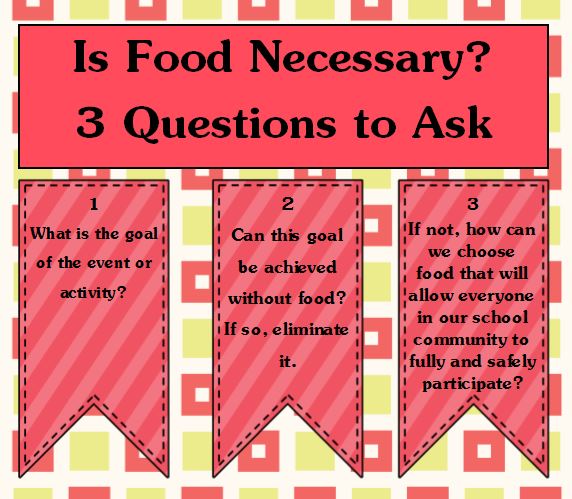I could use small pieces of candy in a math lesson to make the math concept more concrete (and provide an M&M incentive for when we finished the activity). There are just so many teacher tricks that can be implemented with the help of a jelly bean.
In recent years, I have all but eliminated any class activities that involve food. With the rise of food allergies among students, it is just safer and easier to avoid class activities that include edible parts. Recent statistics suggest that 1 out of every 13 kids has a food allergy. This translates to 2-3 students in an elementary aged class who will have some type of reaction to foods. Thankfully, it is often possible to design a school activity in a different way that is still engaging but without the food element.

If you are helping to plan a classroom activity, consider these three questions before deciding to include food items:
- What is the goal of the event or activity?
- Can this goal be achieved without food? If so, eliminate it.
- If food is critical to the success of the event, how can we choose food that will allow everyone in our school community to fully and safely participate?
There are some situations where snacks and treats are the primary reason for holding the class event. Class parties at Halloween, right before the winter holidays, and Valentine’s Day are probably going to include food. But, if you are planning a craftivity to go with the class party, try to organize a craft that does not use edible pieces.
When you do plan a school event that will involve food, never offer snacks to an entire class that contain nuts or nut products since peanut and nut allergies are the most common. Advance notification should be given to parents if food is going to be served in the classroom. THIS TAKES PLANNING! Coordinate with the classroom teacher several weeks ahead of time to accommodate any food sensitivities.
If you are the parent of a child with a food allergy, educate your child about safe practices when activities involve food. If your child is ever in doubt about whether a food is safe to eat, do not risk it. Instruct your child to avoid the food and speak with the teacher or adult in charge.
Guest Contributor: Caitlin Tobin is a mom to two elementary aged children and a teacher. She currently teaches 4th grade but has experience working with children from nursery school up through freshmen in high school. She loves snack foods, crafty projects, and spreadsheets. She is on a mission to help the world choose the perfect teacher gift and writes about many of her ideas at www.The-Room-Mom.com.

